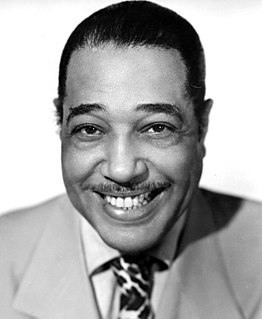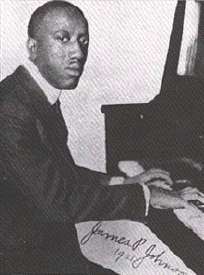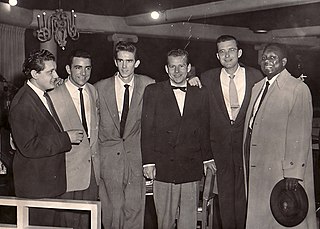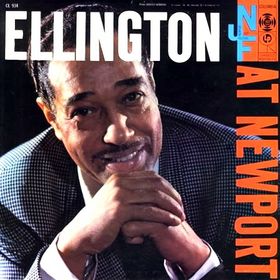Related Research Articles

In music, an arrangement is a musical reconceptualization of a previously composed work. It may differ from the original work by means of reharmonization, melodic paraphrasing, orchestration, or development of the formal structure. Arranging differs from orchestration in that the latter process is limited to the assignment of notes to instruments for performance by an orchestra, concert band, or other musical ensemble. Arranging "involves adding compositional techniques, such as new thematic material for introductions, transitions, or modulations, and endings. Arranging is the art of giving an existing melody musical variety".

Edward Kennedy "Duke" Ellington was an American composer, pianist, and leader of a jazz orchestra from 1923 through the rest of his life.

Cornelius "Johnny" Hodges was an American alto saxophonist, best known for solo work with Duke Ellington's big band. He played lead alto in the saxophone section for many years. Hodges was also featured on soprano saxophone, but refused to play soprano after 1946. He is considered one of the definitive alto saxophone players of the big band era.

Rhapsody in Blue is a 1924 musical composition written by George Gershwin for solo piano and jazz band, which combines elements of classical music with jazz-influenced effects. Commissioned by bandleader Paul Whiteman, the work premiered in a concert titled "An Experiment in Modern Music" on February 12, 1924, in Aeolian Hall, New York City. Whiteman's band performed the rhapsody with Gershwin playing the piano. Whiteman's arranger Ferde Grofé orchestrated the rhapsody several times including the 1924 original scoring, the 1926 pit orchestra scoring, and the 1942 symphonic scoring.
Swing music is a form of jazz that developed in the United States in the 1930s and 1940s. The name came from the emphasis on the off–beat, or weaker pulse. Swing bands usually featured soloists who would improvise on the melody over the arrangement. The danceable swing style of big bands and bandleaders such as Benny Goodman was the dominant form of American popular music from 1935 to 1946, known as the swing era. The verb "to swing" is also used as a term of praise for playing that has a strong groove or drive. Notable musicians of the swing era include Duke Ellington, Benny Goodman, Count Basie, Cab Calloway, Jimmy Dorsey, Tommy Dorsey, Woody Herman, Harry James, Lionel Hampton, Glenn Miller and Artie Shaw.

James Price Johnson was an American pianist and composer. A pioneer of stride piano, he was one of the most important pianists in the early era of recording, and like Jelly Roll Morton, one of the key figures in the evolution of ragtime into what was eventually called jazz. Johnson was a major influence on Count Basie, Duke Ellington, Art Tatum, and Fats Waller, who was his student.

Harry Howell Carney was a jazz saxophonist and clarinettist who spent over four decades as a member of the Duke Ellington Orchestra. He played a variety of instruments but primarily used the baritone saxophone, being a critical influence on the instrument in jazz.
"Take the 'A' Train" is a jazz standard by Billy Strayhorn that was the signature tune of the Duke Ellington orchestra.
"I Got Rhythm" is a piece composed by George Gershwin with lyrics by Ira Gershwin and published in 1930, which became a jazz standard. Its chord progression, known as the "rhythm changes", is the foundation for many other popular jazz tunes such as Charlie Parker's and Dizzy Gillespie's bebop standard "Anthropology ".
Irving Harold Mills was an American music publisher, musician, lyricist, and jazz artist promoter. He sometimes used the pseudonyms Goody Goodwin and Joe Primrose.
"In a Sentimental Mood" is a jazz composition by Duke Ellington. He composed the piece in 1935 and recorded it with his orchestra during the same year. Lyrics were written by Manny Kurtz; Ellington's manager Irving Mills gave himself a percentage of the publishing, so the song was credited to all three. Other popular versions in 1935/36 were by Benny Goodman and by Mills Blue Rhythm Band.

Ellington at Newport is a 1956 live jazz album by Duke Ellington and his band of their 1956 concert at the Newport Jazz Festival, a concert which revitalized Ellington's flagging career. Jazz promoter George Wein describes the 1956 concert as "the greatest performance of [Ellington's] career... It stood for everything that jazz had been and could be." It is included in the book 1001 Albums You Must Hear Before You Die, which ranks it "one of the most famous... in jazz history". Jazz journalist Scott Yanow wrote that Ellington's performance at the 1956 Newport Jazz Festival caused a sensation that fueled the rest of his career.The original release was partly recreated in the studio after the Ellington Orchestra's festival appearance.

William Alonzo "Cat" Anderson was an American jazz trumpeter known for his long period as a member of Duke Ellington's orchestra and for his wide range, especially his ability to play in the altissimo register.
"Diminuendo and Crescendo in Blue" is a jazz composition written in 1937 by Duke Ellington and recorded for the first time on May 15, 1937 by the Duke Ellington Orchestra with Wallace Jones, Cootie Williams (trumpet), Rex Stewart (cornet), Barney Bigard (clarinet), Johnny Hodges, Otto Hardwick, Laurence Brown, Joe Nanton (trombone), Harry Carney, Sonny Greer (drums), Wellmann Braud (bass), Freddie Guy (guitar), and Duke Ellington (piano). No tenor saxophone was present in this recording section, nor in "Crescendo in Blue," which was recorded the same day. In its early form, the two individual pieces, "Diminuendo in Blue" and "Crescendo in Blue," were recorded on opposite sides of a 78 rpm record. The 1956 performance at the Newport Jazz Festival revitalized Ellington's career, making newspaper headlines when seated audience members chaotically began rising to dance and stand on their chairs during Paul Gonsalves's tenor saxophone solo.
Black and Tan (1929) is a musical short film written and directed by Dudley Murphy. The plot is about a couple in the performing arts; it is set during the contemporary Harlem Renaissance in New York City. It is the first film to feature Duke Ellington and His Orchestra performing as a jazz band, and was also the film debut of actress Fredi Washington. The film is thought to express the emergence of African-American artists in New York City during the Harlem Renaissance.

The Carnegie Hall Concerts: January 1943 is a live album by American pianist, composer and bandleader Duke Ellington recorded at Carnegie Hall, in New York City in 1943 and released on the Prestige label in 1977.

The period from the end of the First World War until the start of the Depression in 1929 is known as the "Jazz Age". Jazz had become popular music in America, although older generations considered the music immoral and threatening to cultural values. Dances such as the Charleston and the Black Bottom were very popular during the period, and jazz bands typically consisted of seven to twelve musicians. Important orchestras in New York were led by Fletcher Henderson, Paul Whiteman and Duke Ellington. Many New Orleans jazzmen had moved to Chicago during the late 1910s in search of employment; among others, the New Orleans Rhythm Kings, King Oliver's Creole Jazz Band and Jelly Roll Morton recorded in the city. However, Chicago's importance as a center of jazz music started to diminish toward the end of the 1920s in favor of New York.

Ellingtonia, Vol. One is a compilation album of phonograph records assembled by Brunswick Records during the American Federation of Musicians strike, cataloguing the early, experimental Brunswick and Vocalion recordings of Duke Ellington in the middle of the Harlem Renaissance. During the later Swing era, the recordings were praised for accurately predicting the developments in the Big band genre several years in advance.
References
- ↑ Lawrence, A.H. (2003). Duke Ellington and His World. Routledge. pp. 122–123. ISBN 978-0415969253.